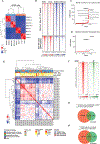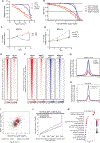A Distinct Chromatin State Drives Therapeutic Resistance in Invasive Lobular Breast Cancer
- PMID: 35950920
- PMCID: PMC9588703
- DOI: 10.1158/0008-5472.CAN-21-3186
A Distinct Chromatin State Drives Therapeutic Resistance in Invasive Lobular Breast Cancer
Abstract
Most invasive lobular breast cancers (ILC) are of the luminal A subtype and are strongly hormone receptor-positive. Yet, ILC is relatively resistant to tamoxifen and associated with inferior long-term outcomes compared with invasive ductal cancers (IDC). In this study, we sought to gain mechanistic insights into these clinical findings that are not explained by the genetic landscape of ILC and to identify strategies to improve patient outcomes. A comprehensive analysis of the epigenome of ILC in preclinical models and clinical samples showed that, compared with IDC, ILC harbored a distinct chromatin state linked to gained recruitment of FOXA1, a lineage-defining pioneer transcription factor. This resulted in an ILC-unique FOXA1-estrogen receptor (ER) axis that promoted the transcription of genes associated with tumor progression and poor outcomes. The ILC-unique FOXA1-ER axis led to retained ER chromatin binding after tamoxifen treatment, which facilitated tamoxifen resistance while remaining strongly dependent on ER signaling. Mechanistically, gained FOXA1 binding was associated with the autoinduction of FOXA1 in ILC through an ILC-unique FOXA1 binding site. Targeted silencing of this regulatory site resulted in the disruption of the feed-forward loop and growth inhibition in ILC. In summary, ILC is characterized by a unique chromatin state and FOXA1-ER axis that is associated with tumor progression, offering a novel mechanism of tamoxifen resistance. These results underscore the importance of conducting clinical trials dedicated to patients with ILC in order to optimize treatments in this breast cancer subtype.
Significance: A unique FOXA1-ER axis in invasive lobular breast cancer promotes disease progression and tamoxifen resistance, highlighting a potential therapeutic avenue for clinical investigations dedicated to this disease. See related commentary by Blawski and Toska, p. 3668.
©2022 American Association for Cancer Research.
Figures






Comment in
-
A Unique FOXA1-Associated Chromatin State Dictates Therapeutic Resistance in Lobular Breast Cancer.Cancer Res. 2022 Oct 17;82(20):3668-3670. doi: 10.1158/0008-5472.CAN-22-2594. Cancer Res. 2022. PMID: 36245246 Free PMC article.
References
-
- Derksen PW, Liu X, Saridin F, van der Gulden H, Zevenhoven J, Evers B, et al. Somatic inactivation of E-cadherin and p53 in mice leads to metastatic lobular mammary carcinoma through induction of anoikis resistance and angiogenesis. Cancer Cell 2006;10(5):437–49 doi 10.1016/j.ccr.2006.09.013. - DOI - PubMed
-
- Pestalozzi BC, Zahrieh D, Mallon E, Gusterson BA, Price KN, Gelber RD, et al. Distinct clinical and prognostic features of infiltrating lobular carcinoma of the breast: combined results of 15 International Breast Cancer Study Group clinical trials. J Clin Oncol 2008;26(18):3006–14 doi 10.1200/JCO.2007.14.9336. - DOI - PubMed
Publication types
MeSH terms
Substances
Grants and funding
LinkOut - more resources
Full Text Sources
Medical
Molecular Biology Databases

